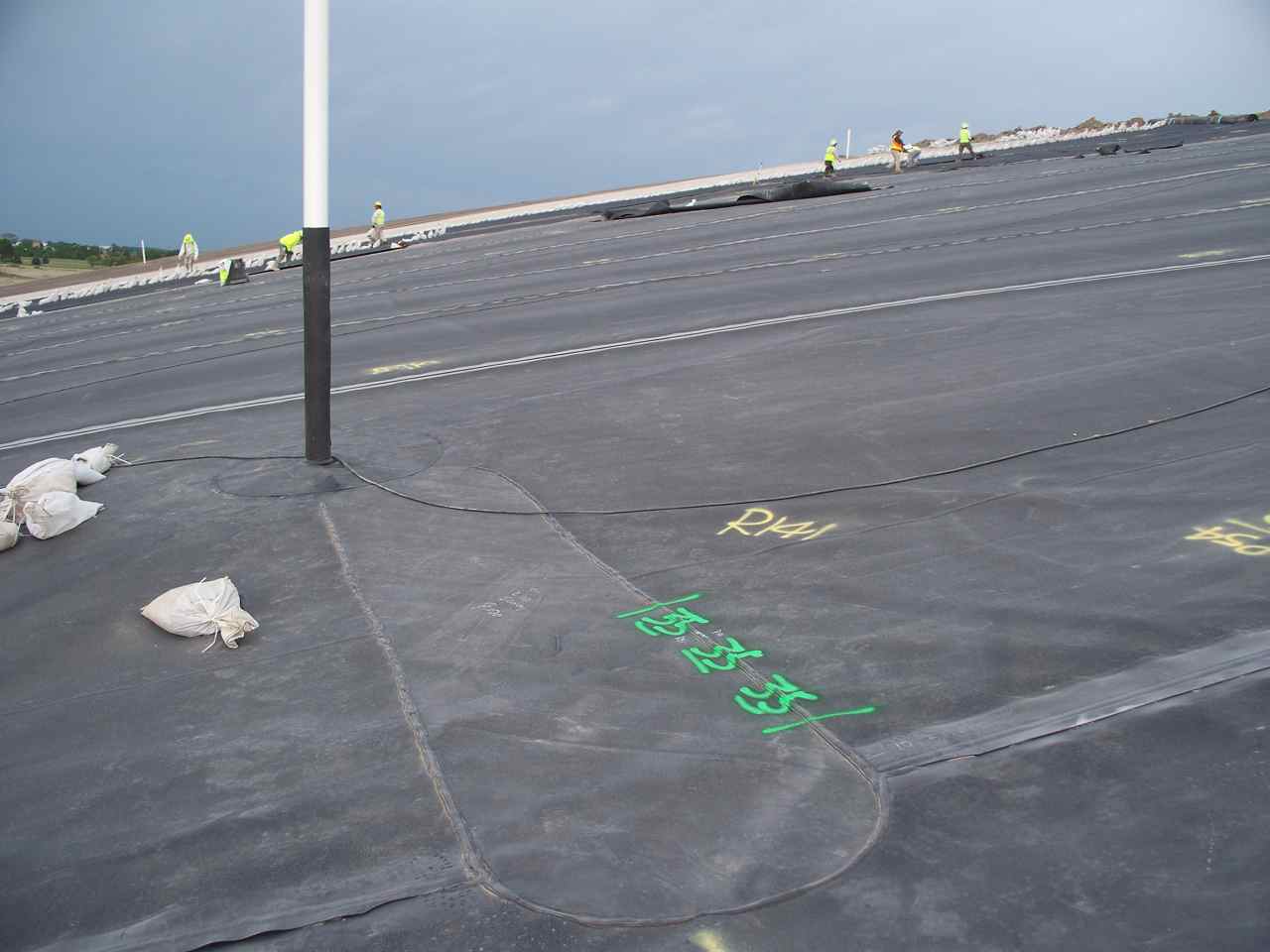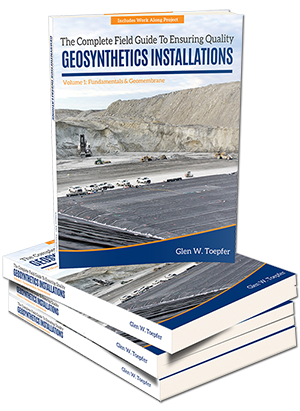Our industry knows we need to change destructive testing protocols but there has been a lack of clear effective guidance on how to accomplish this within our projects.
Studying the successes and failures of seam quality through destructive testing has been a driving passion of mine for decades. When I started my CQA career in the industry 30 years ago, the destructive sampling frequency was 1 sample per 500 lineal feet of welding. I was met by every installer with the same argument “why cut holes in a perfectly sound geomembrane system?” The same argument persists today, as well as the same standard sampling rate. Technology has changed substantially during this time making for better materials and better equipment; however, the fundamentals for making a sound seam have not changed and will not change – you still need the proper mix of heat, speed, and pressure. With this in mind, I thought it would be worth taking a deeper look into welding data.
Since starting my own firm in 2003, I’ve been able to compile data from real world projects to better understand actual field results. Here are a few statistics to ponder:
The following statistics and data on destructive failures come from a paper I coauthored with Mr. Brent Duganiero: “Destructive Sample Failures – Impact on Destruct Sample Failure Rates” presented at Geosynthetics 2019/(Houston, TX; February, 2019). This paper highlights the need to readdress our current protocols and assumptions that fusion welds rarely fail:
- The average failure rate (FR) for all destructs (DS) on a project ranged between 3.7-9.4% and the combined FR average for all projects was 5.4%.
- The Smooth/Smooth (S/S) interface FR across all seven projects ranged from 0% to 6.9% and averaged 4.3%.
- Textured/Textured (T/T) interface FR ranged from 4.2% to 20.0% with an average FR of 10.8%.
- Smooth/Textured (S/T) interface FR ranged from 0% to 25.0% with an average FR of 11.4%.
- The FR of the S/T and T/T interfaces were 271% and 257% respectively higher than the S/S interface.
- Project 1 highlights this issue as 100% of all project DS failures came from the T/T interface that had a 20% FR. So, 28% (by lineal foot) of the project seams were failing at a rate of 20%. But the failures were not tracked by interface type per the existing tracking protocols and all tracking samples immediately passed when tracked onto a S/S interface.
The following data on extrusion welds are excerpts from my paper, “Extrusion Welds-The Good, The Bad, and The Ugly”, presented at Geosynthetics 2015/ (Portland, Oregon; February, 2015) which highlights the need to address these welds in DS testing protocols:
- The extrusion fillet process remains acknowledged among industry professionals as an inferior weld when compared to the thermal fusion method, in part due to the heavy reliance on an individual’s skills.
- Extrusion Repair Welding as Percent of Total Welding ranges between 10.67% and 17.78% on the study projects. This is a substantial amount of the total welding on a project.
- Extrusion Repair Original Sample Failure Rates ranges between 0%-60%.
- Testing failure rates can be up to 5 times greater for extrusion welds than for fusion welds.
In recent years, I field more e-mails and calls on the subject of destructive testing than any other geosynthetics related topic over the course of a construction season. The reasons for these inquiries vary from trying to reduce failure rates to trying to get an accurate representation of seam quality without creating a Swiss Cheese liner.
The first question our industry needs to answer is: do we even need destructive samples anymore? The short answer is “yes”. At the time of this writing, destructs are the only way to cost-effectively test the true integrity of most weld types. Thus, until a better technology is developed, destructive sampling will remain an integral part of geosynthetics installation.
There is somewhat of a false sense of security in our industry when it comes to destructive testing. On one hand, there are false perceptions that newer technologies such as electrical leak location surveys and/or data recording welding machines can replace destructs all together. On the other hand, the perception that destructive failure rates are low causes people to be lax when it comes to developing and enforcing a sampling plan.
One colleague, in regards to fusion welded geomembrane seams, recently stated: “Rates of seam failures have been reduced over time from quite high percentages (10% or more) down to approximately 2% based on laboratory testing of destructive seam samples (recent IFAI data)”. This statement, taken on its own is quite misleading.
Fusion welding has improved significantly since its inception but it is not uncommon for my CQA team to see failure rates of 5% or more and I suspect a significant reason for the difference is how my team implements a destructive sampling plan. Failure rates are only as reliable as the project’s underlying DS processes and protocols combined with their field implementation.
Obtaining a zero-leak liner system that remains zero leaks throughout its life expectancy is unlikely to occur without some form of accountability of weld quality on inferior weld types such as extrusion welds. No sampling plan that I am currently aware of promotes ensuring the testing of different interfaces or testing inferior weld types such as extrusion welds.
That being said, more destructs is not the answer; however, neither is a blind 1 per 500. We need “Smart Destructive Testing” plans.
Reality is many destructive testing protocols are out of date and lack understanding of the nuances of welding in real world conditions. They fail to provide a comprehensive project specific approach to minimizing risk liabilities in both testing procedures and location selection (i.e. what is the risk verse reward of a destruct in a sump or low point).
Appropriate strategies have to consider:
- The realities of field construction
- Weld type
- Interface type
- Material type and quality
- Weld continuity
- Weld strength
- Weather
- Design aspects: purpose, what is contained, life expectancy, tie-ins
- Contractor performance – real-time failure vs success
- Potential damage to installed liner
- Construction cost
- Project timelines – onsite vs offsite testing
- DS failure tracking processes
Creating a comprehensive destructive sampling plan is critical in reducing the long-term liability of the owner, both in identifying and repairing potentially compromised seams as well as minimizing the number of holes in the geomembrane. A good sampling plan does not just throw a destructive sample every 500 lineal feet onto the geomembrane seams – there are many factors to consider and incorporate into an effective plan.
We have grown as an industry over these last 3 decades and with that growth has come a lot lessons learns and real world data. We are ready as an industry to begin to write better specifications and CQA Plans that utilize these lessons learned.
Trying to squeeze DS testing into a blog is nearly impossible. Quite frankly, I could just about write a book on it but since I haven’t done that yet…. I am offering a Webinar dedicated to “Smart Destructive Testing” plans.
Upcoming Live Webinar:
Designing Effective Destructive Testing & Tracking Programs
Including the Impacts of Smart Wedges & ELL Surveys
We all know Swiss Cheese doesn’t hold water! So how do we create effective “Smart” destructive testing protocols that reduce owner liability while not turning our liner systems into Swiss Cheese?
This 1.5-hour webinar will provide you with field tested and proven strategies for ensuring sound weld quality while minimizing the impact of destructive testing on liner systems. The primary focus will be fusion and extrusion welding types with select applications for chemical welding.
Topics include:
- What goes into “Smart” destructive testing plans
- Effect of Interface type on weld quality
- Sophisticated testing protocols vs. 1 per 500
- Impact of Electrical Leak Location survey on DS testing plans
- Current failure rates: weld type, material interface type
- Impact and limitations of Smart Wedges and data recording wedges
- Application & Limitations of destructive testing
- Test location strategies
- DS Tracking Strategies
- Understanding how to calculate accurate failure rates
- Q&A – We will stay online afterwards until all questions have been answered
- Attendees will be issued 1.5 PHD for their attendance.
While this live webinar will primarily focus on HDPE and LLDPE geomembranes, these principles can be applied to other geomembranes.
Date: November 18, 2020
Time: 11am-12:30pm EST
Location: Zoom Live Webinar
Cost: $149 USD
Click here to register for the Webinar.
If you have any trouble registering or would like to register a group, please feel free to call Holly at 419-269-1800.
We look forward to continuing to push our industry forward together!




